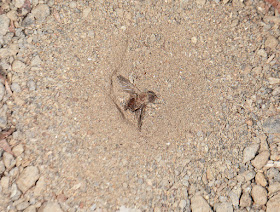I knew that they were most likely antlions (Neuroptera; Myrmeleontidae; Myrmeleontinae) but I thought I should check just to be sure.
Each pit harbours this occupant. It usually is covered with soil and sits, covered at the base of the bit with the jaws agape. In the US these insects are often called Doodlebugs because they created doodle-like patterns when they move about on the surface of the of the ground after dark seeking better places to create a pit. They are very particular as to where they make a pit. They require dry, fine particles. They are at home in what might otherwise be considered as dust. That's why they are often found at the base of trees where it is dry.
We have pesky March Flies (Tabanidae, called Horse Flies in North America) around at this time of year and I decided to see if one would be acceptable to the occupant of the pit above. In no time it was attacked and disappeared beneath the dust.
Antlions are so-called because they are voracious and often feed on passing ants. If the ants attempt to climb out of the pit, the occupant flicks small pebbles at it until it knocks it down. Once in the bottom of the pit, it is usually a goner.
The antlion is a rather plump creature, well adapted for its existence in a world of dust. It is fairly mobile but does not really need to be since it spends most of its time at the bottom of its pit. It has the dubious distinction of lacking an anus. It doesn't need one. It would just pose problems-what to do with waste. Instead it stores its wastes and ejects, if that is the right word, this meconial mass (a word for your next Scrabble game) after it pupates.
Antlion jaws are formed by the mandibles and maxillae and the hollow projections inject inject venom into the prey. You can see the canal in the above photo quite nicely.
At the end of its larval career, which can last for several years, the antlion forms a pupa which will eventually produce at adult antlion.
From the web
Adult antlions are common visitors to light sheets because they are nocturnal. They are especially common in the more arid or open areas of Australia. Even though there are dozens of pits in our carport, I cannot recall ever seeing an adult at the light sheet. I have kept the cocoon to see what eventually emerges.







Great info and photos, Dave. We have a colony of ant lions in the dust next to the garage. I also have Wheeler's book on them (I think that's the author). Maybe I should read it one of these days.
ReplyDeleteCampsite toilet blocks in the outback are a great place to find adult antlions (and many other insects). The lights are left on all night and I have spent many a happy moment with my camera inside or just outside toilet blocks.
ReplyDeleteSusan
ReplyDeleteBetter be careful lurking around toilet blocks! Searching for insects might not hold up in court!
D
Exactly Camera, i never knew things about ant lions. It is amazing to know that this has likely similar life cycle with frog and butterfly and amazing to know that there are types of people who had interested to this tiny creature.
ReplyDeletehervey bay real estate